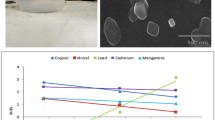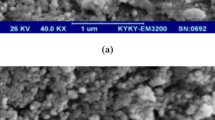Abstract
This study describes the preparation of zinc oxide nanoparticle–chitosan as a solid-phase adsorbent for separation and preconcentration of trace amount of chromium and nickel from environmental water samples and their determination by inductively coupled plasma optical emission spectrometry. Important factors including pH, amount of adsorbent, amount of 1-(2-pyridylazo)-2-naphthol, sample volume, eluent concentration and extraction time were investigated and optimized. The equilibrium data according to the Freundlich’s and Langmuir models were processed. The results showed that the equilibrium data were well fitted with Langmuir isotherm model. The best fit of adsorption kinetics was attained with a second-order equation. Under the optimum conditions, the detection limits for chromium and nickel were 0.041 and 0.039 µg L−1, respectively, and the relative standard deviations (RSD %) were 1.5% and 1.3% (n = 10, c = 50 µg L−1) for chromium and nickel, respectively. This procedure was then used for preconcentration and determination of target compounds from environmental water samples.






Similar content being viewed by others
References
Kiatumjorn T, Rattanarat P, Siangproh W, Chailapakul O, Praphairaksit N. Glutathione and l-cysteine modified silver nanoplates-based colorimetric assay for a simple, fast, sensitive and selective determination of nickel. Talanta. 2014;128:215–20.
Shang Y, Wu F, Qi L. Highly selective colorimetric assay for nickel ion using N-acetyl-l-cysteine-functionalized silver nanoparticles. J Nanopart Res. 2012;14:1169.
Kamakura N, Inui T, Kitano M, Nakamura T. Determination of chromium (III), chromium(VI), and chromium(III) acetylacetonate in water by ion-exchange disk extraction/metal furnace atomic absorption spectrometry. Spectrochim Acta Part B. 2014;93:28–33.
Narin I, Soylak M. The uses of 1-(2-pyridylazo) 2-naphtol (PAN) impregnated Ambersorb 563 resin on the solid phase extraction of traces heavy metal ions and their determinations by atomic absorption spectrometry. Talanta. 2003;60:215–21.
Soylak M, Elci L, Dogan M. Determination of trace amounts of cobalt in natural water samples as 4-(2-thiazolylazo) resorcinol complex after adsorptive preconcentration. Anal Lett. 1997;30:623–31.
Tuzen M, Soylak M. Column solid-phase extraction of nickel and silver in environmental samples prior to their flame atomic absorption spectrometric determinations. J Hazard Mater. 2009;164:1428–32.
Khajeh M, Sanchooli E. Optimization of microwave-assisted extraction procedure for zinc and iron determination in celery by Box-Behnken design. Food Anal Methods. 2010;3:75–9.
Ohata M, Matsubayashi N. Determination of hexavalent chromium in plastic certified reference materials by X-ray absorption fine structure analysis. Spectrochim Acta Part B. 2014;93(93):14–9.
Suleiman JS, Hu B, Peng H, Huang C. Separation/preconcentration of trace amounts of Cr, Cu and Pb in environmental samples by magnetic solid-phase extraction with bismuthiol-II-immobilized magnetic nanoparticles and their determination by ICP-OES. Talanta. 2009;77:1579–83.
Zhao J, Hu Q, Li Y, Liu H. Efficient separation of vanadium from chromium by a novel ionic liquid-based synergistic extraction strategy. Chem Eng J. 2015;264:487–96.
Dongb C, Chena W, Liua C, Liub Y, Liu H. Synthesis of magnetic chitosan nanoparticle and its adsorption property for humic acid from aqueous solution. Colloids Surf A. 2014;446:179–89.
Pal SK, Akhtar N, Ghosh SK. Determination of arsenic in water using fluorescent ZnO quantum dots. Anal Methods. 2016;8:445–52.
Khajeh M, Laurent S, Dastafkan K. Nanoadsorbents: classification, preparation, and applications (with emphasis on aqueous media). Chem Rev. 2013;113:7728–68.
Shokati Poursani A, Nilchi A, Hassani A, Tabibian S, Asad Amraji L. Synthesis of nano-γ-Al2O3/chitosan beads (AlCBs) and continuous heavy metals removal from liquid solution. Int J Environ Sci Technol. 2017;14:1459–68.
Madill EAW, Garcia-Valdez O, Champagne P, Cunningham MF. CO2-responsive graft modified chitosan for heavy metal (nickel) recovery. Polymers. 2017;9:394.
AbdElhady MM. Preparation and characterization of chitosan/zinc oxide nanoparticles for imparting antimicrobial and UV protection to cotton fabric. Int J Carbohydr Chem. 2012;2012:1–6.
Khajeh M, Jahanbin E. Application of cuckoo optimization algorithm–artificial neural network method of zinc oxide nanoparticles–chitosan for extraction of uranium from water samples. Chemom Intell Lab Syst. 2014;135:70–5.
Ghaedi M, Ansari A, Habibi MH, Asghari AR. Removal of malachite green from aqueous solution by zinc oxide nanoparticle loaded on activated carbon: kinetics and isotherm study. J Ind Eng Chem. 2014;20:17–28.
Demirbas O, Karadag A, Alkan M, Gogan M. Removal of copper ions from aqueous solutions by hazelnut shell. J Hazard Mater. 2008;153:677–84.
Panneerselvam P, Morad N, Tan KA. Magnetic nanoparticle (Fe3O4) impregnated onto tea waste for the removal of nickel(II) from aqueous solution. J Hazard Mater. 2011;186:160–8.
Salehi R, Arami M, Mahmoodi NM, Bahrami H, Khorramfar S. Novel biocompatible composite (chitosan-zinc oxide nanoparticle): preparation, characterization and dye adsorption properties. Colloids Surf B. 2010;80:86–93.
Rafatullah M, Sulaiman O, Hashim R, Ahmad A. Adsorption of copper(II), chromium(III), nickel(II) and lead(II) ions from aqueous solutions by Meranti sawdust. J Hazard Mater. 2009;170:969–77.
Peric J, Trgo M, Medvidovic NV. Removal of zinc, copper and lead by natural zeolites: a comparison of adsorption isotherms. Water Res. 2004;38:1893–9.
Jain M, Garg VK, Kadirvelu K. Investigation of Cr(VI) adsorption onto chemically treated Helianthus annuus: optimization using response surface methodology. Bioresour Technol. 2011;102:600–5.
Author information
Authors and Affiliations
Corresponding author
About this article
Cite this article
Khajeh, M., Nemch, T.K. Determination of Chromium and Nickel in Water Samples by Zinc Oxide Nanoparticle–Chitosan: Equilibrium, Kinetic and Thermodynamic Studies. J. Anal. Test. 2, 299–305 (2018). https://doi.org/10.1007/s41664-018-0067-3
Received:
Accepted:
Published:
Issue Date:
DOI: https://doi.org/10.1007/s41664-018-0067-3




